Mangrove Trinity
Whenever you are at the brink of water on this East coast the mangrove thickets will not be far away. They walk with multiple legs on the shifting places of the continent, where liquid changes to mud, mud to dry land, they straddle sea to shore, wave to tideline, follow the path of rivers to estuaries. They are the middle section of the broad three piece jigsaw that locks the rainforest with the reef, the pin that at makes sense of the vast and complex system that keeps the north East of Australia a viable, productive and balanced place.
Despite the devastation of the reef, at the moment they seem to continue to hold things together ecologically. There are 35 species of mangrove listed, each one adapted to a specific part of the margin, from wet through to dry. This is one on Trinity Beach is one of the commonest, red mangrove with its feet in the water at high tide and holding the sand together at low. Consolidating the shore line of Australia is a major function, catching the particles eroded from the land and stabilizing the coral sand washed up as on this very lovely beach. A downside is that the pools and puddles of water trapped behind are a breeding ground for mosquitoes and having to have forgotten to put on insect repellent my arms look like they have an attack of measles by the end of the walk.
They are also a filter system that can take up nitrates from agricultural run-off – up to a point. Algal blooms, as we have had in some of our Lakes, are becoming more common as are the incidence of box jellyfish which thrive in soupy waters.
Many nature programs have emphasised their importance as a protective nursery for baby fish. These swim safely until they make their way eventually out to sea or re-stock the reef. And they have their own permanent residents, frogs, fiddler crabs , mud skippers and water rats.
However, if or when, the coral skeletons crumble and the reef disintegrates they will have a major problem surviving because the reef protects them from the worst of the cyclones, stopping the pounding of the waves and currents that will damage and uproot them. In this case the Australian Dream of a house on the Gold, Sunshine, and all the other Eastern coasts may be washed and blown away.
However, with a Government who seriously considers blowing a few holes in the reef to allow bigger ships in to service the mining industry maybe it is immaterial.
- 0
- 0
- Olympus VG160,X990,D745
- 1/30
- f/2.8
- 5mm
- 200

Comments
Sign in or get an account to comment.


